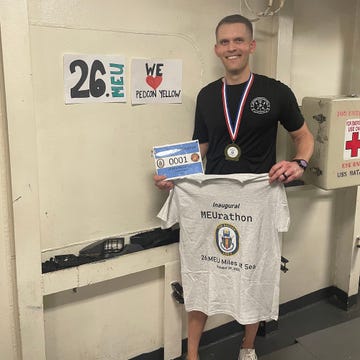There’s no doubt that running—or regular endurance exercise of any description, for that matter—changes your heart.
The heart is a muscular organ, after all, and like all muscles, it adapts to the stress of exercise. Whether these adaptations are good or bad has been debated for over a century, but the current view is that the most obvious changes are, at worst, harmless. The athlete’s enlarged heart? That’s just stronger muscle and bigger chambers to pump more blood, not a sign of heart failure. The low resting heart rate? It’s not a sign of an arrhythmia—an irregular or abnormal heart rhythm—as it would be in a nonrunner; it’s just that each contraction sends so much blood shooting through your blood vessels that the heart doesn’t need to beat as often.
In recent decades, most of the discussion about running and cardiac risk has focused on sudden deaths at marathons and other endurance events—highly public, man-bites-dog events that inevitably make it into the newspapers. In 1977, a cardiologist and 2:28 marathoner named Paul Thompson, M.D., was running Bay to Breakers 12K when one such death occurred. The tragedy sparked a lifelong and career-defining interest for Thompson, who is now the co-physician-in-chief of the Hartford Health-Care Heart and Vascular Institute and perhaps the world’s leading authority on the cardiac consequences of running. In 1979, Thompson published a report on 18 men and women who died during or immediately after running, 13 of whom had heart disease. “Superior physical fitness does not guarantee protection against exercise deaths,” he and his coauthors warned.
Such deaths were rare in the 1970s partly because running as a mass-participation sport was new: There were only 16,233 marathon finishers in the U.S. in 1975. Four decades later, in 2015, there were more than half a million. As a result, marathon deaths have transformed from shocking anomaly to annual certainty: An analysis by a team with Aaron Baggish, M.D., of the Massachusetts General Hospital’s Cardiovascular Performance Program counted 59 sudden cardiac arrests in U.S. half marathons and marathons between 2000 and 2010, 42 of them fatal. They still make headlines and provide ammunition for those who argue that running is dangerous—but the truth is, when runners younger than about 40 die during a race, it’s usually the result of an undiagnosed genetic heart abnormality like hypertrophic cardiomyopathy (when the heart muscle gets abnormally thick, impeding the pumping of blood); when older participants die, they usually had pre-existing heart disease. And sometimes, there’s no apparent explanation. But whatever the cause, the heart’s electrical system goes haywire, causing an arrhythmia called ventricular fibrillation in which the heart stops pumping blood.
If that were the whole story, the case against running would be easily dismissed. Yes, vigorous activity—whether it’s running, shoveling, or having sex—temporarily raises your risk of sudden cardiac arrest. But exercising on a regular basis has such a dramatic effect on other cardiac risk factors like blood pressure, obesity, and cholesterol that its protective benefits during your 23 nonexercising hours each day totally swamp any risks during exercise itself.
That’s not the whole story, though. The latest iteration of the discussion focuses less on sudden deaths and more on the possibility that decades of regular running can contribute to gradual wear and tear on your heart and blood vessels. According to this theory, each marathon you run pushes your heart a little beyond its limits, and over time all the vigorous beating leads to patches of fibrosis, or scarring. That fibrosis, along with other accumulated damage, might lead to atrial fibrillation, in which your regular heartbeat is replaced by rapid and irregular beating. And the turbulent flow of blood through your coronary arteries during running might contribute to the formation of artery-clogging plaques, raising the risk of a heart attack (a blockage of bloodflow to the heart that can, in turn, lead to sudden cardiac arrest, in which your heart stops completely).
All of this means—in theory, at least—that dedicated long-term runners should be less healthy and long-lived than their more casual peers. It’s only now, four decades after the first running boom, that we finally have large numbers of men and women entering their retirement years having run for most of their adult lives. And their mortality statistics reveal that—well, interpreting those stats correctly is what scientists have been arguing about, the media has been sensationalizing, and that random dude at the gym has been lecturing you about.
It was at the 2012 American College of Sports Medicine (ACSM) meeting in San Francisco that this debate erupted in earnest. A team led by Duck-chul Lee, Ph.D., an epidemiologist then at the University of South Carolina, presented an analysis of more than 50,000 patients who had visited the Cooper Clinic in Texas between 1971 and 2002, including 14,000 who reported running as one of their regular activities. The good news: Within an average follow-up period of 15 years from their initial visit, the runners were 19 percent less likely to have died than the nonrunners. The bad news: Those benefits accrued primarily to men and women running less than 20 miles per week. Those who ran more than this seemingly modest threshold were statistically no better off than the nonrunners.
In the same week, a review by Kansas City cardiologist James H. O’Keefe, M.D., and several colleagues was published in the Mayo Clinic Proceedings, summarizing the potential negative cardiac effects of too much running: fibrosis, calcified arteries, arrhythmias. It was a potent one-two punch, with O’Keefe’s paper explaining what could go wrong and Lee’s conference presentation offering evidence that it was really happening. News outlets around the world picked up the story, amplified on social media by a mix of fear and—let’s be honest—schadenfreude. Those annoyingly smug runners who think they’re so healthy? Ha, I guess the joke’s on them.
Later in 2012, O’Keefe and Carl J. Lavie, M.D., a cardiologist in New Orleans who coauthored both Lee’s and O’Keefe’s earlier papers, wrote an editorial in the journal Heart summarizing the findings and arguing that vigorous exercise should be limited to 30 to 50 minutes a day. “In contrast,” they wrote, “running too fast, too far, and for too many years may speed one’s progress towards the finish line of life.” Again, the story was catnip to news editors, spurring another round of warnings. That pattern recurred repeatedly over the next few years: Between 2012 and 2015, O’Keefe alone wrote or coauthored more than a dozen academic publications about the dangers of excessive endurance training, mostly commentaries, reviews of previous findings, and letters to the editor, and gave a TEDx Talk that was viewed more than 400,000 times. With repetition, the headlines became increasingly familiar and the claims began to feel like fact.
In truth, the evidence was still very much in dispute. The next study to garner headlines about the risks of too much running, from a group in Copenhagen, turned out to be drawing its conclusions from just two deaths among “strenuous” runners—a statistically dubious claim that incited an avalanche of criticism from other researchers. And Lee’s data from the 2012 ACSM conference, though it was frequently cited as evidence of running’s deadly potential, still hadn’t gone through peer review to be published in an academic journal. In a 2013 response to O’Keefe and Lavie’s Heart editorial, Thomas Weber, Ph.D., a cardiovascular researcher at Icahn School of Medicine at Mount Sinai in New York, pointed out a seeming flaw in Lee’s statistical analysis: The researchers had “adjusted” the data to eliminate differences in body mass index, blood pressure, and cholesterol levels—precisely the risk factors that running would be expected to lower. “Put simply,” Weber wrote, “this editorial represents a selective interpretation of the available data, at the best.”
Weber's critique highlights one of the central challenges of public-health research: How do you compare groups of people with widely differing behaviors and physical characteristics? Among the Cooper Clinic subjects, for example, those who ran the most were a little older on average, more likely to be former smokers, and included more women and individuals with a family history of heart disease compared with those who ran less. Each of these factors affects mortality in different ways, making a straight comparison between the groups impossible. Instead, epidemiologists use a technique called “statistical adjustment” to correct for these differences, effectively allowing them to compare groups as if everyone had the same age, smoking history, and so on.
But this process breaks down when the differences between the groups are a direct consequence of the behavior you’re studying. If you want to compare the death rates of smokers and nonsmokers, you might find that the smokers have higher rates of lung cancer. But it would be incorrect to “statistically adjust” the results to make the rates of lung cancer equal between the two groups, because smoking causes lung cancer, which in turn raises death rates. The difference in lung cancer rates between smokers and nonsmokers isn’t a fluke to be brushed aside; it’s the whole point! Weber was pointing out a similar problem in the Cooper Clinic analysis. Running is well-known to lower BMI, blood pressure, and cholesterol levels, which in turn reduces the risk of heart disease. By equalizing these parameters, the researchers were effectively saying: If you ignore the known health benefits of running, running has no health benefits.
Lee and his colleagues finally published their Cooper Clinic data in the Journal of the American College of Cardiology in 2014, more than two years after it was first presented at the ACSM meeting. In its peer-reviewed version, the data was presented without the controversial statistical adjustment—and the message was very different. Instead of warning about the dangers of running more than 20 miles a week, the authors emphasized the benefits of a very modest amount of running—five to 10 minutes a day—which created a dramatically lower risk of dying from heart disease. Running more than that didn’t offer further benefits, but neither, in the revised analysis, did it make things obviously worse.
The media reaction, this time, was a little more muted. “The press loves the ‘exercise is bad’ story,” says Lavie, one of the paper’s coauthors. “But we wanted to emphasize that even a little running is good.” Still, the debate was far from over. The highest-mileage runners in the study were logging just 176 minutes of running per week—and even at that relatively modest level, the range of uncertainty in the data left open the possibility that they might have a higher risk of death from heart disease than nonrunners.
The first day of this year’s American College of Sports Medicine conference in Boston fell, as fate would have it, on Global Running Day. At the convention center, all the heavyweights were there for a special symposium called “Optimal Dose of Running for Health: Is More Better or Worse?” There was Duck-chul Lee, Carl Lavie, and Paul Thompson, along with Paul T. Williams, Ph.D., a biostatistician at Lawrence Berkeley National Laboratory in California, whose National Runners’ and Walkers’ Health Studies have been following 156,000 men and women since the early 1990s.
The epidemiological debate pitted Lee, a genial ex-bodybuilder from South Korea who is now an assistant professor at Iowa State University, against Williams. In contrast to four years earlier, Lee emphasized the benefits of just a little vigorous exercise—five to 10 minutes a day, which is less, even, than the standard recommendation of at least 75 minutes per week—for living longer. His 2014 paper had divided the Cooper Clinic subjects into five groups based on weekly running mileage; at this symposium he presented a deeper look at the quintile doing the most running, splitting them into three subgroups. There was a hint that cardiac risk might be edging up for the top subgroup, but there was still no statistically significant increase in risk. “It doesn’t support that more is worse,” Lee says. “But more may not be better.”
Williams, on the other hand, argued that more really is better, at least in some cases. His 156,000 subjects, many initially recruited from among Runner’s World subscribers, walk or run 156 million miles per year, giving him a massive data set to explore. Over the years, he has published 65 studies on how running affects conditions ranging from diabetes and stroke to cataracts, Alzheimer’s, and kidney and breast cancers. In nearly every case, not only does running help, but more is better. For example, men running at least 40 miles a week were 26 percent less likely to develop coronary heart disease than those meeting health guidelines by running just 13 miles a week. Why the apparent contradiction with Lee’s results? Williams had been carefully diplomatic throughout his talk, but he permitted himself a faint smile when the question was posed to him during the Q&A session. “At 156,000 subjects, we’re bigger than they are,” he said. “So I’ll stand behind our data.”
While the epidemiological data is reassuring for most runners, it doesn’t tell us much about those at the extreme edge of the curve—those for whom 40 miles a week is just a warmup. For these runners, the best data we have comes from looking directly at what changes, and what potential warning signs show up in their hearts after decades of training. In separate talks at the conference, Lavie and Thompson offered the cardiologist’s perspective on these heart changes.
The most well-documented risk is atrial fibrillation, the most common type of the irregular or abnormal heart rhythms known as arrhythmias. Atrial fibrillation has been linked in several studies to cumulative years of exercise—most likely, Thompson said, because of an enlarged left atrium, where blood is stored after it returns from the lungs. While the condition can raise the risk of stroke when combined with other risk factors like high blood pressure or diabetes, it’s generally more of an inconvenience than an imminent threat. Not everyone agrees that running is a risk factor—in Williams’s data, those running more than 39 miles per week were less likely to report cardiac arrhythmias than any other group—but Thompson and many others are convinced that it is.
A more serious concern is the possibility that high doses of exercise can cause atherosclerosis, as calcium-rich plaques accumulate in the arteries leading to your heart. This is the condition that was diagnosed in 1968 Boston Marathon winner Amby Burfoot. The resulting narrowed and stiffened arteries can gradually reduce the supply of blood to the heart—or a plaque can suddenly rupture and cause a more serious blockage, triggering a heart attack. It’s possible that the turbulent rush of blood through these arteries during exercise accelerates plaque formation, or that exercise alters hormone levels associated with plaques. It’s also possible that the people who choose to run the most are also different in other ways, Lavie noted: “They may have extreme personalities, so they’re always mentally stressed and sleep-deprived and so on.”
Even less clear is whether the plaques in marathoners’ arteries pose the same risks as the plaques in nonrunners. More and bigger plaques are bad news, but denser plaques actually lower the risk of heart disease, Thompson said—and there’s mounting evidence that marathoners tend to have dense, stable plaques that are much less likely to rupture and cause a blockage. For example, British researchers presented data at a conference last year showing that long-term runners and cyclists—the 169 subjects had been training for an average of 7.7 hours a week for 31 years—had more highly calcified arteries if they ran at least 35 miles a week. But more than 70 percent of plaques in male athletes were dense, stable plaques, compared with just 30 percent in nonathletes. “For me,” says cardiologist Ahmed Merghani, who led the study, “the plaque morphology and what a plaque looks like is more important than the presence or absence of atherosclerosis.”
Perhaps the most controversial topic is fibrosis, patches of scar tissue that may accumulate in the heart after prolonged wear and tear and could contribute to other conditions, such as atrial fibrillation. In 2011, British researchers examined the hearts of a remarkable group of 12 veteran athletes who had been training hard for an average of 43 years and had completed an average of 178 marathons, 65 ultramarathons, and four Ironman triathlons each. Half of them showed signs of fibrosis—”an unexpectedly high prevalence.” In contrast, a German study earlier this year assembled an equally remarkable group of 33 master endurance athletes with an average age of 45, including former Olympians, a marathon champion, and Iron-man winners, and found no evidence of exercise-induced fibrosis in any of them. Thompson’s take: The phenomenon is probably real, but very rare.
After each of the ACSM talks, the speakers were surrounded by crowds of eager questioners, many with the lean and hungry look that betrayed their personal interest in the topic. Are there risk differences between men and women? (Lee’s take: Based on his data, the benefits and risks of running seem similar for both sexes, though there was a trend suggesting greater health benefits for women.) A slim woman with dark hair approached Thompson and began peppering him with technical questions about his research. Then she drew closer and lowered her voice: “Another, more personal question. Do you take patients?”
By now, if you’re like me, you’re probably thoroughly confused. The hearts of longtime runners are indeed different, it seems, but the consequences are unclear. The best way to get an answer would be a clinical trial in which people were randomly assigned to run various weekly distances for decades. “But that’s impossible,” Lavie says. “You can do it for 12 weeks, but not for long-term studies.” So we’re stuck making our decisions with imperfect information.
Even if we did have perfect information, though, we’d still be left to roll the dice—as we do in countless decisions every day. What if it turned out that running at least 40 miles a week would extend life by two years for 99 percent of people, but shorten it by 10 years for the other 1 percent? Would you carry on? What if, instead, the proportions were 99.9 percent and .1 percent? Such decisions are deeply uncomfortable, which is why we avoid thinking about them when we, say, take an antibiotic or step outside on a sunny day. That’s why, for Thompson, the fruits of the debate are “intellectually interesting, clinically worth knowing, but not worth worrying about.”
That calculus would change if we could figure out, in advance, who is among the .1 percent with a vulnerable heart. We know that rare heart conditions like arrhythmogenic right ventricular cardiomyopathy are associated with certain genetic defects, and those who have the defect are more likely to develop the disease if they exercise a lot. Perhaps the same will turn out to be true for fibrosis and atrial fibrillation: Exercise raises your risk, but only if you already have the genetic predisposition. “I think this is a potential game-changer,” Thompson says of the future prospects of genetic testing. That doesn’t mean people with the wrong genes won’t run, but they’ll understand the risks—and perhaps seek fulfillment from 10Ks rather than 100-milers.
By the end of the conference, I was feeling pretty good about my own running routine. Right now, with a 2-year-old and a newborn at home, I’m lucky to log 30 miles in any given week, and my racing is limited to 5Ks and 10Ks. In the future, though, I dream of exploring some trail or mountain ultras, to push my limits in a different way. If nothing else, this whole debate will remind me not to take my own invincibility for granted—to be aware that my arteries could get clogged or my heart’s rhythm could go haywire. Whether or not running raises or lowers the chance of this happening, being aware of the risk will help me watch for warning signs.
For now, even Lavie is loathe to discourage anyone from running. “I don’t think the data is nearly enough to say ‘Stop at 30 miles per week,’ “ he told me when we met after his talk. He wants his patients to understand that the biggest health benefits of running can be obtained from as little as five or 10 minutes a day—that they don’t need to be marathoners to be healthy, and that pushing to extremes may even whittle away some of those benefits. If they’re older and have other risk factors for heart disease, he might suggest an exercise stress test and coronary artery calcium testing, and treat high cholesterol with statins. “If someone is running 40 miles per week, then I ask what their purpose is,” he says. “If they love it, I’m not going to try to scare them.”
This moderate answer catches me by surprise: Having read the scary news headlines, I had expected to meet a strident anti-running crusader. But Lavie is not that guy. He heads out at lunch most days for a 45-minute run, logging more than 30 miles a week. It used to be higher, but he now hits the elliptical once or twice a week to let his legs recover. He still races, and though age has slowed his times, he still cares about the results. And like most runners, once he’s out on the roads, floating along under the Louisiana sun, he’s no longer thinking about his heart. “It’s a stress-relief. I feel better. I’m able to eat more,” he says. “But mostly, I enjoy it.”
* * *
For more on runners and their hearts, see our entire “The Runner’s Heart” presentation.













